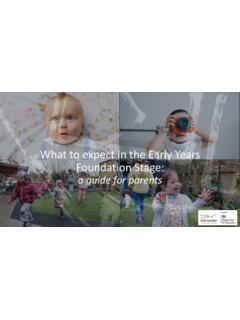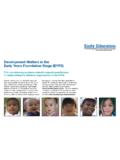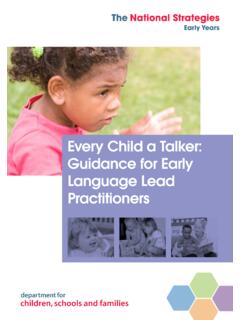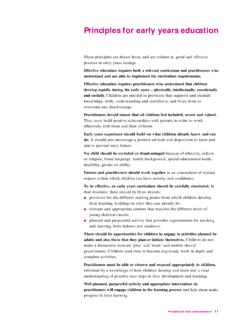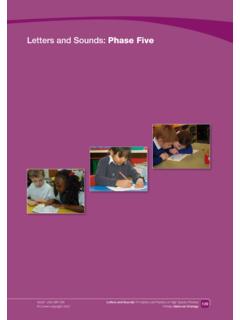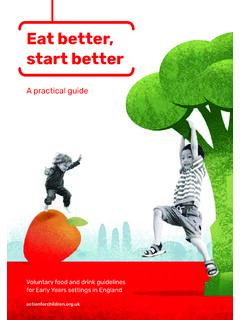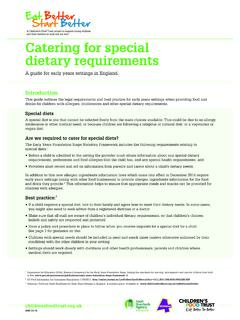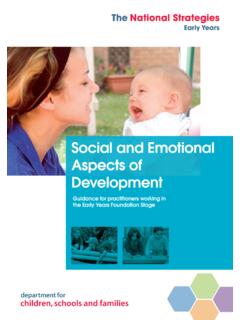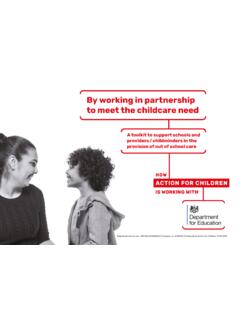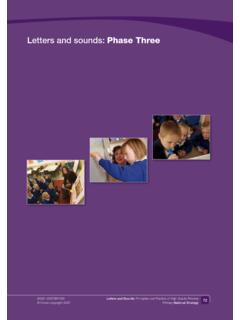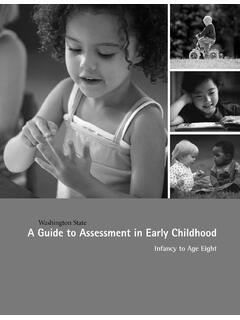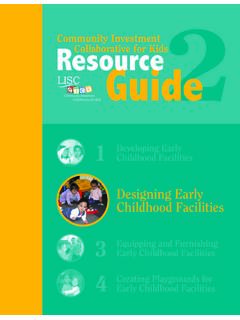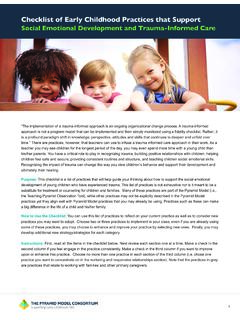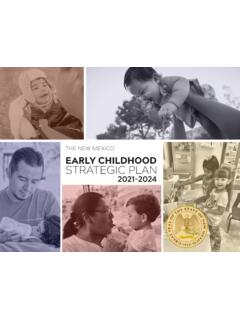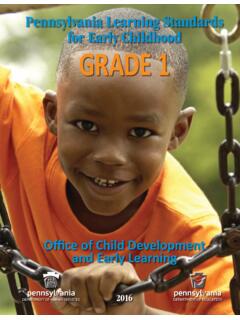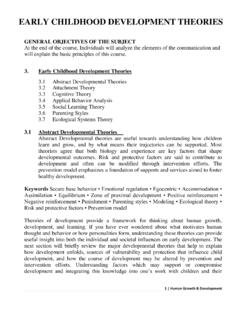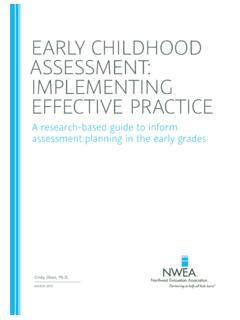Transcription of Guide to the Early Years Foundation Stage in Steiner ...
1 Guide to the Early Years Foundation Stage in Steiner Waldorf Early childhood SettingsGuide to the Early Years Foundation Stage in Steiner Waldorf Early childhood SettingsWHITE HORSE PRESS 11-20091 Guide to the Early Years Foundation Stage in Steiner Waldorf Early childhood SettingsContentsForeword by Christopher Clouder 3 Introduction4 Section 1: EYFS: Principles into practice6 Section 2: EYFS: Learning and Development requirements14 Section 3: Examples of how the Learning and Development requirements are experienced in Steiner settings19 Section 4: Observation, assessment and planning 33 Section 5: Learning and Development exemptions and inspection39 Section 6: Further reading and useful addresses 40 Section 7: Acknowledgements423 Guide to the Early Years Foundation Stage in Steiner Waldorf Early childhood SettingsForeword In recent Years Early childhood education and care has been increasingly seen as vitally important in both a political and social context across the globe.
2 In many respects we have come a long way since the pioneering work of Rachel and Margaret McMillan in Deptford nearly a century ago. This is to be sincerely welcomed, and the Steiner Waldorf movement in the UK commends the Westminster government s achievements in the last decade in increasing the profile accorded to Early education within the policy agenda and the corresponding growth in the allocation of resources to the well-being of the young the new vocabulary of education and care words such as creativity, citizenship, emotional learning, childhood well-being, and personal, social and health education are current, alongside the public requirements for assessment and evaluation. One aspect depends on an implicit freedom for practitioners to use their vocational skills in areas that are basically immeasurable, together with their professional insight and sense of responsibility. The other seeks to make their services accountable to the general good by requiring a healthy degree of transparency and cooperation.
3 This will always require a delicate balancing act that accordingly respects a diversity of approach and the individuality of each child, and also the needs of the community at large. Steiner education strives to bridge the divide by allowing children to grow into freedom and works with a methodology that stresses the importance of age-appropriateness, at the same time creating a secure environment of warmth and care within which the individuality of the child can find its own potential. Simultaneously it views teaching as a learning profession where we can all do better for the children in our care by working individually inwardly and also outwardly together, either as an institution or as colleagues across a wider spectrum, in a way that supports and enhances our professional development and competencies. This booklet, as a product of this form of cooperation, illustrates precisely that process in both making Steiner Waldorf principles and practice more visible and available, while at the same time elucidating and developing them in the context of our times.
4 This is an exercise we welcome as, in a way, it is a coming of age for Steiner Waldorf provision in this country. As a human endeavour a good quality Early upbringing is crucial for the future of all our societies, and we wish to make our full contribution to this and simultaneously get better in what we do. Christopher ClouderChair Steiner Waldorf Schools Fellowship4 Guide to the Early Years Foundation Stage in Steiner Waldorf Early childhood SettingsIntroductionThe Early Years Foundation StageEvery child deserves the best possible start in life and support to fulfil their potential. A child s experience in the Early Years has a major impact on their life chances. A secure, safe and happy childhood is important in its own right, and it provides the Foundation for children to make the most of their abilities and talents as they grow up. When parents choose to use Early Years services they want to know that provision will keep their children safe and help them to thrive.
5 The Early Years Foundation Stage (EYFS) is the framework that provides that assurance. The overarching aim of the EYFS is to help young children achieve the five Every Child Matters outcomes of staying safe, being healthy, enjoying and achieving, making a positive contribution, and achieving economic well-being by: setting the standards for the learning, development and care young children should experience when they are attending a setting outside their family home, ensuring that every child makes progress and that no child gets left behind; providing for equality of opportunity and anti-discriminatory practice and ensuring that every child is included and not disadvantaged because of ethnicity, culture or religion, home language, family background, learning difficulties or disabilities, gender or ability; creating the framework for partnership working between parents and professionals, and between all the settings that the child attends.
6 Improving the quality and consistency in the Early Years sector through a universal set of standards which apply to all settings, ending the distinction between care and learning in the existing frameworks, and providing the basis for the inspection and regulation regime; laying a secure Foundation for future learning through learning and development that is planned around the individual needs and interests of the child, and informed by the use of ongoing observational EYFS was given legal force from September 2008 and became mandatory for all schools and Early Years providers who care for children from birth to the end of the academic year in which a child has their fifth birthday. Providers must follow the Statutory Framework for the EYFS and ensure their provision complies with the learning and development requirements ( Early learning goals, educational programmes and assessment arrangements) and the welfare requirements.
7 In addition, the Statutory Framework contains guidance that all providers must have regard to and, if they decide to depart from it, they must have clear reasons for doing so and be able to demonstrate that their alternative approach achieves the ends described in this document gives the Steiner view on how the EYFS learning and development principles and goals might be addressed within the Steiner Waldorf Early childhood curriculum, and will Guide the reader through each section covering the principles, practice and learning and development requirements. This document does not replace the EYFS and has no legal effect. If any Steiner setting believes that its established principles about learning and development for young children conflict with elements of the EYFS learning and development requirements, it is open to the setting to apply for exemption from elements of the EYFS learning and development requirements.
8 All applications will be assessed on a case-by-case basis. Please visit the QCDA website for further information on how to apply: If you would like to find out about Steiner practice, please contact the Steiner Waldorf Schools Fellowship for to the Early Years Foundation Stage in Steiner Waldorf Early childhood SettingsIt is expected that the reader is familiar with the EYFS Statutory Framework and guidance, as not all areas have been addressed, only those which in the view of Steiner Waldorf Schools Fellowship may benefit from some further explanation and clarification for Steiner Waldorf practitioners and others reading this document. More information on the documents is referred to in the Department for Children, Schools and families (DCSF) does not endorse the Steiner interpretation of the EYFS learning and development requirements. This guidance is strictly the Steiner Waldorf interpretation of the Statutory Framework for the EYFS and that interpretation is not binding on the DCSF or Ofsted.
9 Providers must follow the Statutory Framework for the EYFS and will be inspected by Ofsted against this Framework except where an exemption has been Steiner Waldorf approachThe Steiner Waldorf approach is founded on the work of the Austrian philosopher and educationalist Rudolf Steiner , who wished to create a form of education which would help pupils achieve clarity of thought, sensitivity of feeling and strength of will. After listening to his lectures, the workers at the Waldorf-Astoria cigarette factory in Stuttgart asked him to form a school for their children and in 1919 the first Waldorf School was founded. Today, from the favelas in Sao Paulo to the villages of Nepal, there are some 800 schools and over 2000 Early Years settings in over 60 countries serving children from birth to 18 Years of age. The kindergartens began in 1926, and spread first amongst the European countries, then into the UK and USA, before spreading throughout the Steiner approach to the care of young children encompasses birth to seven Years and includes parenting, home childcare and pregnancy.
10 In addition to providing kindergartens (three to six plus), Steiner Early childhood settings usually include sessions for parent and child groups (birth to three Years ), playgroups and nursery groups (two-and-a-half to four Years ), where an understanding of this approach is developed before the child starts kindergarten. The Steiner Waldorf Early childhood approach takes as given the interdependence of physical, emotional, social, spiritual and cognitive development. It takes account of the whole child, including his/her soul qualities, and believes that children s learning flourishes in a calm, peaceful, predictable, familiar and unhurried environment that recognises the child s sensory sensitivities. Young children need to experience the relevance of their world before they separate themselves from it and begin to analyse it in a detached way. Learning gains meaning by its relevance to life and should not be separated from the business of daily living.
